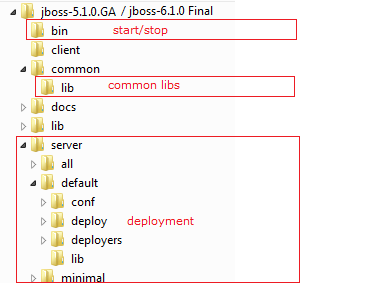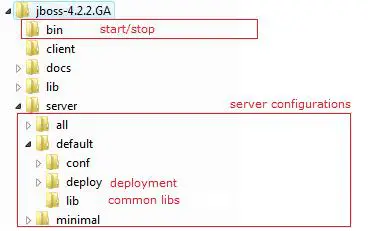Important notice: This tutorial covers the releases 4-5-6 of the application server. If you want to check the latest AS 7 version, we suggest you looking at the following tutorial
JBoss application server can be freely downloaded from the Community site http://www.jboss.org/jbossas/downloads/The installation of JBoss is simply a matter of extracting the compressed archive into a folder.
In order to start up JBoss correctly, you have to define the environment variable JAVA_HOME to the location where you have installed Java.
After you have installed JBoss, perform a simple startup test to validate that there are no problems with your Java VM/operating system combination. To test your installation, move to the bin directory of your JBOSS_HOME/bin directory and issue the following command:
run.bat # Windows users
$ run.sh # Linux/Unix users
JBoss AS 5-6 configuration:
Let's have a look at the application server folders for the releases 5 and 6:
Here's a description about the single folders:
| bin | This directory contains the scripts necessary to start-up and shutdown the server. This folder also contains some scripts (like twiddle) there are a few utilities for web services and server management |
| client | This directory contains the client libraries needed to run client applications |
| common | This directory contains the lib folder which is the new repository for the common libraries used by all application server configurations. |
| docs | This folder contains the xml schemas used by the various xml configuration files and useful JMS, JTA and Datasource configuration examples which can be used as templates |
| lib | This is the repository for all JBoss bootstrap libraries. Here is the new Micro-container along with earlier JMX kernel |
| server | This directory is the home of all server configurations. Here you can find the built-in server configurations (minimal, default, standard, web and all). Each server configuration contains the following directories in the next table |
Place in the folder common/lib the libraries which are shared between all your server configuration
JBoss 5 and 6 available server configurations:
JBoss 5 and 6 ship with a set of pre-built server configurations. Most of the time you'll need to use the "default" configuration for single node applications and "all" for clustered applications. Here's anyway a description of each configuration:
The "default" configuration:
This is the basic JBoss configuration containing a default set of services. It has the most frequently used services required to deploy a JEE application. It does not include the JAXR service, the IIOP service, or any of the clustering services.The "all" confuguration:
This configuration is a full JEE server profile with enterprise extensions such as Clustering and RMI/IIOP.Inside each server configuration there's one more level containing the single server configuration and deployed artifacts. Here' s the next level:
The "standard" configuration:
The standard folder hosts the configuration that has been tested for Java EE 5.0 compliance. The major differences with the other server existing configurations is that call-by-value and deployment isolation are enabled by default, along with support for RMI-IIOP and jJUDDI. .
The "web" configuration
The "web" configuration is a new experimental lightweight configuration created around JBoss Web that will follow the developments of the Java EE 6 web profile. Besides being a servlet/jsp container (and this is the most relevant difference with a pure Ttomcat Web Server), it provides support for JPA and JTA/JCA.The "minimal" configuration
This is the has a minimal configuration—the bare minimum services required to start JBoss. It starts the logging service, a JNDI server and a URL deployment scanner to find new deployments. This is what you would use if you want to use JBoss to start your own services without any other JEE technologies. This is just the bare server. There is no web container, no EJB or JMS support. This is not a JEE compatible configuration.Inside each server configuration there's one more level which contains the configuration folders, the deployment folder and others. Here's a table which resumes the server structure:
| conf | This is the configuration directory of the single server configurations. |
| data | The data directory is a location available for use by services that want to store content in the file system |
| deploy | The default location for deployment of JBoss services |
| deployers | Contains all the JBoss AS services that are used to recognize and deploy different application and archive types |
| lib | This folder used to contain the common libraries of all applications. You can use this directory for storing configuration-specific libraries |
| log | The default directory into which the bootstrap logging service places its logs |
| tmp | The location to which deployments are copied for local use |
| work | Used by JBoss Web Server (the web container that comes prepackaged with JBoss AS) to store compiled JSP files and other temporary data. |
JBoss AS 4 configuration
Let's have a look at the application server folders for the release 4:
Here's a description about the single folders:
| bin | This directory contains the scripts necessary to start-up and shutdown the server. This folder also contains some scripts (like twiddle) there are a few utilities for web services and server management |
| client | The JARs that are required for clients that run outside of JBoss are located in this directory. |
| docs | This folder contains the xml schemas used by the various xml configuration files and useful JMS, JTA and Datasource configuration examples which can be used as templates |
| lib | This is the repository for all JBoss bootstrap libraries. |
| server | The JBoss server configuration sets are located under the server directory. The default server configuration set is the server/default set. JBoss ships with minimal, default and all configuration sets. |
| conf | The conf directory contains the jboss-service.xml bootstrap descriptor file for a given server configuration. This defines the core services that are fixed for the lifetime of the server. |
| data | The data directory is a location available for use by services that want to store content in the file system |
| deploy | The default location for deployment of JBoss services |
| lib | This is the default location for static Java libraries that should not be hot deployed. All JARs in this directory are loaded into the shared classpath at startup. |
| log | The log directory is the directory log files are written to. This may be overridden through the conf/log4j.xml configuration file. |
| tmp | The location to which deployments are copied for local use |

No comments:
Post a Comment